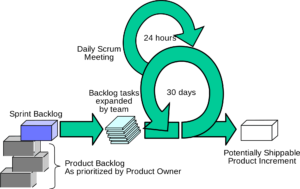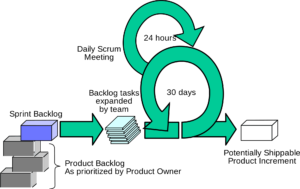3 min read
What is Agile Development? - Meaning, Types & Business Uses
Anurag : Nov 14, 2017 10:00:00 PM

Agile development is a software development methodology that uses an iterative process of Agile project management viz. plan, develop and deploy to meet the changing client needs while ensuring fast development of prototypes. In the agile process of product management, the requirements and solutions evolve through collaboration between self-organizing cross-functional team members. Agile philosophy promotes a disciplined project management process and team working that encourages frequent scrutiny and adaptation with the idea to deliver working software. It encourages leadership, teamwork, self-organization, human development, and accountability.
The Agile methodology focuses on the rapid delivery of an application in fully functional components. Rather than determining stages, all time is “time-boxed” into phases called “sprints.” A sprint is a timeline (usually in weeks) with a running list of deliverables. These deliverables are prioritized on the basis of business goals and market conditions. The work can be reviewed by the project team and customer through daily builds and demos at the end of each sprint.
The agile framework methodology uses a set of engineering best practices that allow for rapid application development and delivery. It is a preferred development practice by C-level executives since it aligns the business objectives, customer needs and company goals with the application development and counters product backlog.
Core Values of Agile Development:
In 2001, 17 leading figures in the software industry created the Agile Manifesto that highlighted the core values of the agile approach and agile method. The entire agile movement or agile development process is based on concepts of the Agile Manifesto.
The agile software development emphasizes four core values:
- Focus on individual interactions and teamwork over processes and tools.
- Priority to development of working software over comprehensive documentation.
- Precedence to Mutual collaboration with the customer over contract negotiation.
- Flexibility to respond to change over following a rigid plan.
Business Case for Agile Development:
The two popular development methodologies used today include waterfall and agile method. While waterfall development focuses on the sequential building of the product, agile works in iterations. Both are popular for their own reasons and the choice clearly depends on the project.
Waterfall is a linear approach where the sequence of events starts with gathering the requirements and moves through design, coding, unit and system test and user acceptance testing (UAT) to the final delivery. This approach works well because of minimal communication needed with clients. Since requirements are decided beforehand it provides scope for more organized development. This approach fails in case we need to pivot the product according to changes in market conditions or client needs. Due to working in a sequential order a lot of work has to be redone.
Agile development, on the other hand, is an iterative, team-based approach to development. It focuses on complete customer involvement throughout the development cycle. It works great when we are working on heavy solutions where final features of the product are not yet finalized. If you are focusing on the lean startup approach of developing a minimum viable product before launching the final product then agile development is a suitable choice. On the contrary, if you have a fixed goal in mind then waterfall is a good option since it won’t involve too much of your attention and can be easily performed by remote teams.
Read More: Why Should Startups Consider ROR for Rapid Application Development?
Popular Agile Development Methodologies:
-
Scrum:

SCRUM is an agile development methodology that focuses on task management in a team-based development environment. Scrum supports working in small development teams (say- 7 to 9 members) and empower them to develop a product with mutual co-operation. Scrum brings everyone on the team, from a product owner or business stakeholders to developers, together to agree on features and methodology. Specific goals are then determined for a 30-day sprint, at the end of which the requisite software prototype is delivered.
-
Extreme Programming (XP):
Extreme Programming technique is effective when there are frequent changes in demands or requirements from the customers or when they are unsure about the features of the application. It emphasizes frequent "releases" of the prototype product in short development cycles. This improves the productivity of the developer team and introduces checkpoints where any latest changes can be easily implemented. The extreme programming focuses on the customers above all other things.
-
Lean software development:
Lean software development emphasizes on optimal utilization of resources in the development process. The aim is to improve efficiency and minimize waste. Waste, here, in the lean philosophy, refers to anything that doesn't add value to the product thus, giving it a very broad definition which is open to interpretation.
In a typical software development cycle, many loopholes remain in the optimization of code. In lean development, we streamline every part of the software development lifecycle and develop the final product with minimal code. With lean methodology, minimal waste can be managed at all levels.
A lean product development team should focus on client requirements and customer feedback and use them as guides for future development. Apart from the core offering of the solution all additional features should be decided on after the release of the initial model to eliminate the need to redo work due to changes in market conditions.
If you are looking for web or mobile application developers then you at the right place. At NewGenApps, we have worked on innovative solutions and technologies and have an expertise of more than 10 years. Contact us today for a project consultation or POC.
-
Dynamic Systems Development Method (DSDM):
Dynamic Systems Development Method or DSDM is an agile project delivery framework. DSDM was first used as a software development method and covers a range of activities in the complete project lifecycle. DSDM includes strong foundations and governance.
The DSDM Agile Project Framework is an incremental and iterative approach that embraces agile practices of development, including ongoing and complete customer involvement.
The Dynamic Systems Development Method is considered to be a broad range of iterative and incremental development frameworks and especially supports object-oriented and agile approaches.



